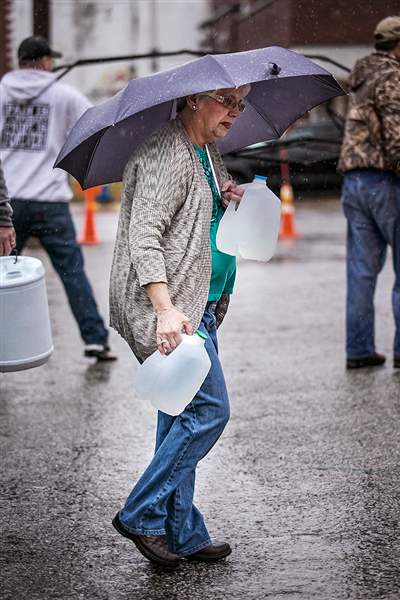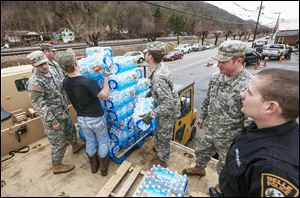
Questions in W.Va. swirl as spill crisis continues
Toxic leak’s extent, firm’s safety record unclear
1/12/2014
Residents in Kanawha County, West Virginia, pick up bottled water. Today will be the fourth day without tap water.
ASSOCIATED PRESS

Members of the West Virginia Army National Guard, plus a member of the Belle Police Department and a volunteer, move emergency water from a military truck to a forklift in Belle, W.Va.
CHARLESTON, W.Va. — As thousands of residents in southern West Virginia remain under an order to not use tap water, questions including exactly how much of the chemical leaked into a river and when people can resume everyday tasks are unclear.
According to one state official, the company where the leak occurred knew it needed to improve its safety measures.
Michael Dorsey, chief of homeland security and emergency services for the West Virginia Department of Environmental Protection, said Freedom Industries had just put $1 million in escrow to fix the secondary containment — the concrete block wall through which the chemical escaped — at the site where the spill occurred.
“They hadn’t gotten a chance to do it yet,” he said, citing a conversation with the company’s president, Gary Southern. The investment was part of the company’s agreement to purchase the property in the last 30 days, Mr. Dorsey said Mr. Southern told him.
A spokesman for Freedom didn’t return a message and the company was not invited to a press conference Saturday, a spokesman for West Virginia Gov. Earl Ray Tomblin said.
Mr. Dorsey said the chemical — thinner than water with an unmistakable licorice odor — escaped through a hole in the steel tank, about an inch in diameter. Eventually, it pooled near the secondary container barrier, an “old concrete wall,” then seeped through the cracks in the mortar.
It was still unclear how the hole formed, but Mr. Southern suggested Friday that the recent cold temperatures might have compromised the container’s structural integrity.
Because the company stores materials and doesn’t produce chemicals, it’s not permitted or inspected by the Department of Environmental Protection, said Tom Aluise, department spokesman.
Mr. Dorsey said Saturday it appears 7,500 gallons of the chemical — 4-methylcyclohexane methane — escaped from the tank, higher than officials’ previous estimates. How much went into the Elk River is not yet known.
Seventy-three people have gone to area hospitals with symptoms such as nausea, eye irritation, or vomiting. Five had been admitted to two local hospitals, said Karen Bowling, secretary of the West Virginia Department of Health and Human Resources.
Sen. Jay Rockefeller (D., W.Va.) said Saturday the U.S. Chemical Safety Board will look into the spill. “I am profoundly troubled by yesterday’s chemical spill and am concerned about the problems it is causing hundreds of thousands of West Virginians across nine counties,” he wrote in the letter dated Friday. “This incident has significant economic, public health, and safety impacts, and West Virginians are seeking answers as to why this happened so that it never occurs again.”
Board Chairman Rafael Moure-Eraso said: “This incident continues to impact the people of West Virginia — our goal is to find out what happened to allow a leak of such magnitude to occur and to ensure that the proper safeguards are in place to prevent a similar incident from occurring.”
Despite the unknowns, businesses forced to close after the spill received some good news.
Business owners can submit a plan outlining how they would operate on alternate sources of potable water, and health officials in Kanawha and Putnam counties will review them for approval.
“The good news here is that we have begun opening restaurants,” said Dr. Rahul Gupta, county health officer for the Kanawha-Charleston and Putnam County boards of health.
“We will work around the clock, 24-7, and try to open ... as many businesses as possible in the next couple of days.”
Lisa Cordiro, a spokesman for the West Virginia Department of Education, said superintendents in the affected counties, who are in contact with their respective emergency management officials, will decide today if schools will open Monday, provided the order is lifted.
The West Virginia National Guard has been running hourly tests on the chemical’s concentration since Thursday night. One part per million is considered a safe level. Initial tests showed Friday the level has dropped from 2 parts to 1.7 parts per million.
Officials would not give specifics on the latest levels, saying experts needed to review the data.
The leak shut down businesses, schools, offices, and left 300,000 people across nine counties without water for washing dishes or bathing and and prompted state and federal disaster declarations.
Residents were out Saturday refilling water supplies at grocery stores and water distribution sites in the region. Some even placed containers outside to collect rainwater from morning rainstorms.
“I got my bucket sitting out in the rain. I’m waiting for Mother Nature to help out,” said Shirley Parliament, 56.
The Federal Emergency Management Agency delivered more than a million liters of water from Maryland on Friday and 800,000 liters Saturday. Another 800,000 liters were set to arrive today.
The Brother’s Brother Foundation said it is working with Gleaning for the World to provide water in the area.
Gleaning for the World sent six tractor-trailer loads of bottled water to FEMA and faith-based distribution sites.
Pinch firefighter Lt. Bob Jeffries, 45, said someone dropped off 90 milk jugs at the site Friday for others to use.
Sue Cottrell pushed a shopping cart of empty containers outside the tanker and waited her turn. It was her first time coming out for water for herself and her husband.
“There’s no use in worrying,” Ms. Cottrell, 74, said. “It could have been worse.”
The Associated Press contributed to this report.
Block News Alliance consists of The Blade and the Pittsburgh Post-Gazette. Molly Born is a reporter for the Post-Gazette.
Contact Molly Born at:
mborn@post-gazette.com
or 412-263-1944.